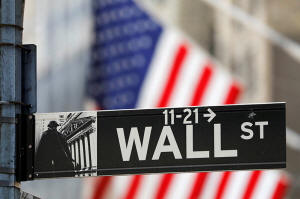'Overdue' pullback in US stocks to test dip-buyers' resolve
 Send a link to a friend
Send a link to a friend
 [April 22, 2024] By
Lewis Krauskopf and Saqib Iqbal Ahmed [April 22, 2024] By
Lewis Krauskopf and Saqib Iqbal Ahmed
NEW YORK (Reuters) - The first sharp pullback for U.S. stocks in half a
year is leaving investors wondering whether to buy the dip or hold out
for more declines.
Following several turbulent weeks, the S&P 500 is down more than 5% from
its March 28 closing high, its biggest retreat since October. Though
they have been rare in recent months, such drops are not uncommon: The
S&P 500 has experienced an average of three pullbacks of 5% or more
every year since 1929, a Bank of America analysis showed.
Many market participants believe the factors that drove the S&P 500 to a
10% gain in the first quarter - including resilient economic growth and
excitement over artificial intelligence - remain in place and will
support stocks over the long term.
For the last week, however, sellers have had the upper hand. The S&P 500
fell for its sixth straight session on Friday, the longest such streak
since October 2022.
While some investors are already buying on weakness, others are waiting
for more clarity on the path of inflation, geopolitical tensions in the
Middle East and the strength of corporate earnings before jumping in.
A pullback is “long overdue,” said King Lip, chief strategist at Baker
Avenue Wealth Management. “I think it's a garden variety correction at
this point.”

Lip has started adding equity exposure for clients and plans to buy more
if stocks slide further. Nevertheless, he believes the S&P 500 could
fall by as much as 10% from its March 28 high.
History shows that strong starts to a year are often followed by sizable
retreats, after which the stock market typically rights itself and
continues higher.
The S&P 500 has seen an average maximum drawdown of 11% each time it has
gained 10% or more in the first quarter, a study from Truist Advisor
Services showed. The index has ended the year higher in 10 out of 11
such instances since 1950.
"We're not surprised that there was a bit of a pullback," said Sonu
Varghese, global macro strategist at Carson Group, who has been using
the recent weakness as an opportunity to increase positions in small-cap
stocks.
"I think buyers will start stepping in," he said.
Still, investors have grown cautious. Clients of BofA sold $800 million
in U.S. equities in the latest week, the third straight week they were
net sellers, the firm said last Tuesday.
Meanwhile, some volatility-sensitive funds that bought equities as
markets marched higher have already started selling and could dump more
stocks if markets grow more turbulent. Analysts at Nomura estimate such
funds could dump around $45 billion worth of stocks if the S&P 500
averages daily moves of 1% over the next two weeks.
[to top of second column] |

A street sign for Wall Street is seen outside the New York Stock
Exchange (NYSE) in New York City, New York, U.S., July 19, 2021.
REUTERS/Andrew Kelly/File Photo

Investors are also watching the level of the Cboe Volatility Index.
Though the index stands around a six-month high of 19, some
volatility watchers believe it has not fully factored in the
inflation worries and geopolitical rumblings that have spooked
markets in recent weeks.
"With the current situation in the Middle East potentially
escalating, I am surprised short term volatility isn't higher," said
Seth Hickle, managing partner at Mindset Wealth Management.
"We have repositioned a small number of positions, but I am waiting
to see how earnings look before making any big changes to our
portfolios."
Indeed, many believe the coming week’s earnings from some of the
market’s biggest names could offer support to stocks - or further
exacerbate the selloff. Tesla, Meta Platforms, Alphabet, and
Microsoft are all scheduled to report in the coming days.
So far, the earnings picture has been mixed. Netflix shares fell on
Friday as its plan to stop sharing subscriber numbers from 2025
stoked growth worries, while Taiwan Semiconductor Manufacturing Co,
the world’s largest contract chipmaker, dialed back expectations for
chip sector growth.
"As the S&P 500 valuation remains over 20 times forward earnings ...
any disappointment from the mega-tech names reporting could push
this week’s oversold market deeper into oversold territory," wrote
Quincy Krosby, chief global strategist for LPL Financial, in a
Friday note.
Investors will also focus on Friday's release of the monthly
Personal Consumption Expenditures Price index, a crucial piece of
inflation data before the Fed's April 30-May 1 meeting.
Stronger-than-expected inflation has eroded a key driver of the bull
market, with investors now pricing in around 40 basis points of
interest rate cuts this year, compared to 150 priced in at the start
of 2024.
Tim Ghriskey, senior portfolio strategist for Ingalls & Snyder in
New York, said he has been “doing some buying on the dip in very
aggressive portfolios” but remains concerned about incoming
inflation data.

"Resumption of disinflation is key" to averting the fear of Fed rate
hikes, he said.
(Reporting by Lewis Krauskopf and Saqib Iqbal Ahmed; additional
reporting by Laura Matthews; Editing by Ira Iosebashvili and Cynthia
Osterman)
[© 2024 Thomson Reuters. All rights
reserved.]
This material may not be published,
broadcast, rewritten or redistributed.
Thompson Reuters is solely responsible for this content. |